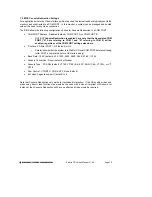
Elektra CPU User Manual V1.00
Page 31
8. SYSTEM I/O
8.1 Ethernet
ELEKTRA includes a 10/100Mbps Ethernet connection using Cat-5 (100BaseT) wiring. The
signals are provided on a 6-pin header (J4) on the right edge of the board.
Diamond Systems’ cable no.
6981002
mates with the header and provides a standard RJ-45
connector in panel-mount form for connecting to standard Cat5 network cables.
1 Common
2 RX-
3 Common
4 RX+
5 TX-
6 TX+
Table 14: J11 – Ethernet Connector
The Ethernet chip is the National Semiconductor DP83815 MacPhyter chip. It is connected to the
system via the board’s internal PCI bus.
The ELEKTRA Software CD includes Ethernet drivers for Windows 95, Windows 98, Windows
NT, and Linux. The latest drivers can also be downloaded from National Semiconductor’s website
at www.national.com. Search for DP83815 to reach the product folder.
A DOS utility program is provided for testing the chip and accessing the configuration EEPROM.
Each board is factory-configured for a unique MAC address using this program. To run the
program, you must boot the computer to DOS. The program will not run properly in a DOS
window inside of Windows. In normal operation this program should not be required.
Additional software support includes a packet driver with software to allow a full TCP/IP
implementation.
8.2 Serial Ports
ELEKTRA contains 4 serial ports. Each port is capable of transmitting at speeds of up to
115.2Kbaud. Ports COM1 and COM2 are built into the standard chipset. They consist of standard
16550 type UARTs with 16-byte FIFOs.
Ports COM3 and COM4 are derived from an Exar 16C2850 dual UART chip and include 128-byte
FIFOs. Ports 3 and 4 may be operated at speeds up to 460Kbaud with installation of high-speed
drivers as a custom option.
The serial ports use the following default system resources:
Port Address
range
IRQ
COM1
I/O 3F8 – 3FF
4
COM2
I/O 2F8 – 2FF
3
COM3
I/O 3E8 – 3EF
9
COM4
I/O 2E8 – 2EF
15
Table 15: COM PORT Default Resource Listing
















































